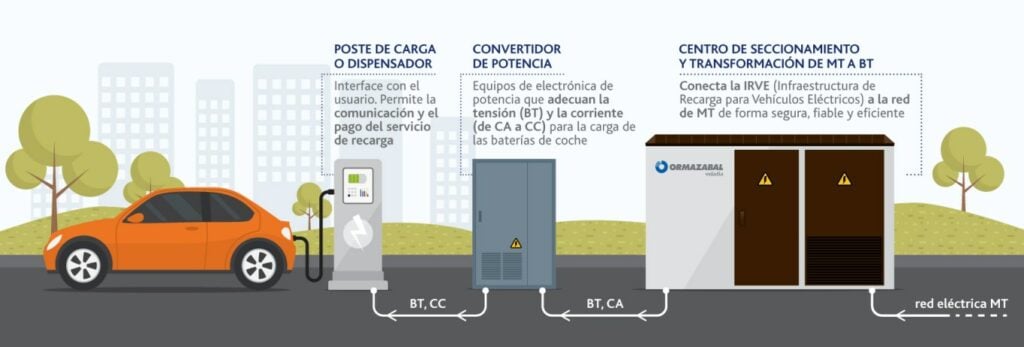Table of Contents
- 1. Electric vehicle charging infrastructure: the cornerstone of sustainable mobility
- 2. Benefits of charging infrastructure for sustainable mobility
- 2.1. Reduction of greenhouse gas emissions
- 2.2. Improvement of air quality in urban areas
- 2.3. Diversification of the energy matrix
- 3. Challenges and solutions for the implementation of charging infrastructure
- 3.1. Challenges of charging infrastructure
- 3.2. Proposed solutions
- 4. The future of sustainable mobility
- Conclusion
- Bibliographic references:
In recent years, sustainable mobility has emerged as a key solution to address the challenges of climate change and environmental pollution. Electric vehicles (EVs) have been highlighted as a promising alternative to traditional cars powered by fossil fuels. However, to achieve mass adoption of EVs, it is essential to have a suitable charging infrastructure.
The integration of electric vehicle charging infrastructure has emerged as a key factor in promoting sustainable mobility. With the increase in environmental awareness and the need to reduce greenhouse gas emissions, electric vehicles have gained relevance as an alternative to conventional internal combustion vehicles. However, for this transition to be successful, it is important to have an efficient and accessible network of charging points for electric vehicles.
The EV charging infrastructure not only makes it possible to overcome the limited autonomy barrier of these vehicles, but also directly impacts the mass adoption of electric mobility and contributes to the reduction of environmental pollution. Next, an explanation is presented about how the incorporation of charging infrastructure for electric vehicles is transforming the scenario of sustainable mobility and the various aspects of its impact on society and climate change ”.
1. Electric vehicle charging infrastructure: the cornerstone of sustainable mobility
The electric vehicle charging infrastructure is a fundamental pillar for the success of sustainable mobility. Without an accessible and reliable network of charging stations, EV drivers face the fear of running out of power in the middle of their journeys, known as “range anxiety”. The implementation of a well-planned charging infrastructure is essential to ensure the widespread acceptance of electric vehicles and overcome the barriers that currently limit their mass adoption.

Electric vehicle charging infrastructure
2. Benefits of charging infrastructure for sustainable mobility
2.1. Reduction of greenhouse gas emissions
EV electrification of transport contributes significantly to reducing greenhouse gas emissions, which are one of the main causes of climate change. With extensive and accessible charging infrastructure, more people are incentivized to switch to electric vehicles, thus decreasing the carbon footprint of the transport sector.
2.2. Improvement of air quality in urban areas
Electric vehicles do not produce local emissions in their operation, which implies a considerable improvement in air quality in urban areas. Reducing air pollution has a positive impact on public health and decreases respiratory and cardiovascular problems associated with poor air quality.
2.3. Diversification of the energy matrix
The mass adoption of electric vehicles implies a greater demand for electric power. By integrating EV charging infrastructure with renewable energy sources, such as solar and wind, it is possible to diversify the energy matrix, reduce dependence on fossil fuels and move towards a more sustainable and resilient energy system.
3. Challenges and solutions for the implementation of charging infrastructure
3.1. Challenges of charging infrastructure
- Implementation and maintenance costs.
- Coordination between actors involved (government, companies, vehicle owners, etc.).
- Availability of adequate spaces for the installation of charging stations.
- Charging standards and plug compatibility.
3.2. Proposed solutions
- Incentives and subsidies for the installation of charging infrastructure.
- Public-private collaboration to share costs and resources.
- Integration of charging infrastructure in urban development and city planning.
- Establishment of unified norms and standards for charging electric vehicles.
4. The future of sustainable mobility
The successful unification of the electric vehicle charging infrastructure is a fundamental step towards a future of sustainable mobility. With the growing awareness of the importance of reducing emissions and preserving the environment, it is essential to continue investing in the expansion and improvement of the EV charging station network. In addition, technological developments in batteries and fast charging methods will also help facilitate the mass adoption of electric vehicles around the world.
Conclusion
The integration of electric vehicle charging infrastructure is a key element in promoting sustainable mobility. By removing the barriers associated with “range anxiety” and encouraging the adoption of electric vehicles, progress is being made towards a cleaner, more environmentally friendly society. Collaboration between governments, industry and citizens will be essential to achieve an accessible and sustainable charging infrastructure, thus creating a cleaner and healthier future for generations to come.
Bibliographic references:
- GRANT THORNTON SPAIN. The Sustainable Mobility of the future and the impact on the SDGs. Consulted on July 26, 2023; https://www.grantthornton.es/contentassets/0129da793696451d80a8d6d0d9285cc6/iii_observatorio-de-movilidad_la-movilidad-sostenible-del-futuro-y-el-impacto-sobre-los-ods_digital.pdf
- IN IT. Electric mobility and its advantages; Consulted on July 27, 2023; https://www.enelamericas.com/es/stories/a202110-elctrica-mobility-y-its-advantages0.html
- CONTRERAS LISPERGUER RUBEN. Impacts of electromobility in the region’s electricity sector; Consulted on July 28, 2023; https://plataformaurbana.cepal.org/sites/default/files/2022-04/Impactos %20de% 20la %20electromovilidad% 20en %20el% 20sector %20el% C3 %A9ctrico% 20en %20la% 20regi %C3% B3n.pdf

